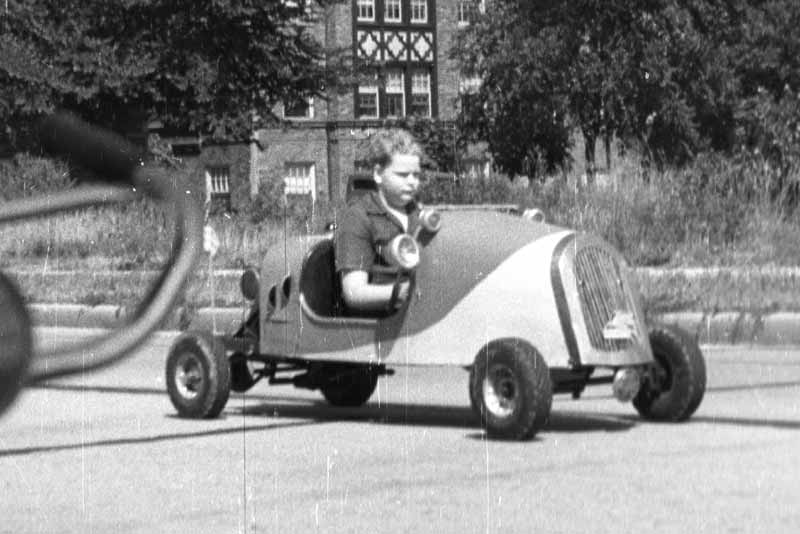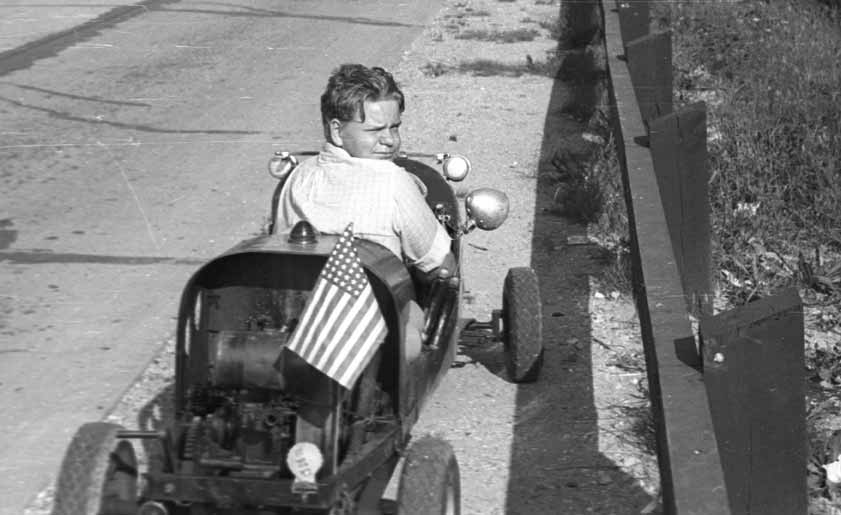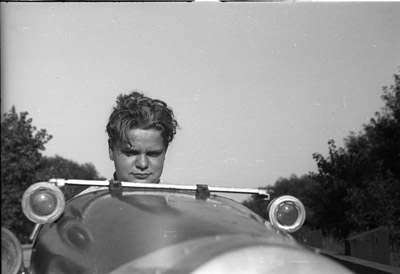- Excerpt
from George Underwood's Autobiography - "Life in the Not-So-Fast
Lane"
The years of 1932, 33 and part of 34 must have been the most uncomfortable
years of my life (to date, that is). After the first year at the Chicago
Unit, at least I was
ambulatory, using crutches and ready to face the world again. When I
got home and my
folks saw the problem of getting around and enjoying the outdoors like
all the friends that
I grew up with. The bicycle that I had won was out of the question but
my sister hooked
the wagon to the rear fender with a rope and away we went to the stores,
rides to get me
motivated I guess.
Dad kept busy trying to think of the right gadget to do the job for me.
His first
idea was to convert the old wooden wagon to something like an ‘Irish
Mail’ only with
one lever on the right side and connected to the rear wheel. That worked
OK but the right
arm got tired in a few minutes. Scratch that idea unless you could make
both arms work,
but one had to steer. The next plan was not so simple but for an electrician
it should be
duck soup, right? Read on. He cut a hole in the bottom of the wooden
wagon to hold a 6-
volt automobile storage battery; got a starter motor from the junkyard
and made a pivot
with the old lever. A wooden ‘vee’ belt pulley was mounted
on the side of the rear wheel,
and pulling the lever would tighten the belt at the same time touching
a switch to turn on
the motor. Great so far, so some of the kids gathered to see it go!!
I felt like a test pilot at
the throttle and I was only 8_ years old. Here we go!! I pulled the lever
back and almost
went out the front of the wagon—it was wired in reverse! It was
fixed in a few minutes
and tried again. It went like Hell and had to be tickled to go slow.
It was easy to dump the
thing over when going around a turn too sharp. The brake was another
lever of wood that
rubbed the rear tire. It kept the driver busy making it work but I was
the envy of all my
sudden friends. Deemed, too dangerous, Dad gave up and decided to make
something
that would be more of a machine than these “Rube Goldberg” things.
|
- It was amazing to see what was growing in the basement.
A single-cylinder, one horsepower
gasoline engine built by Maytag Co. for washing-machine power, showed
up
from a friend who had an engine shop and store. The cost was $52.00;
it had valves in the
head with exposed rocker arms and push rods from the camshaft. Instead
of a rope starter,
it had a segment gear on a lever that would engage the cranking ratchet.
Seemed great
but trying to get it to run on the concrete floor to check it out was
almost impossible,
without anchoring it to a frame or bench. Had to wait till later. No
plans were drawn, just
chalk marks on the floor while I watched what was happening and learning
a whole lot
that I used later in my life. He started the frame with a long piece
of 1_" channel; cutting
notches with a hand hacksaw to allow the steel to be bent into a frame
that was about 7 ft
long and about 24 inches wide. The ends were narrower to give a taper
to the front and
rear with straight sides for about 36 inches. When satisfied that this
was the right shape
he wanted he took it to the neighborhood tire shop who had a welder man
that got
interested and did the work after hours for free, I think. All of the
joints were heavy
brazed and looked very professional. The rest of the work was done in
a similar manner
The clutch was a unit from a shop where the machines were driven by overhead
belts and long drive shafting. It was a ‘cone type’ that
had a tapered cone and by moving
the hub sideways a finger would slide up the cone and would turn a bolt
about _turn,
enough to clamp a split hub tight to grab the rotating inner hub. With
a system of a bell
crank and lever the clutch could be operated easily and lasted for the
known life of the
vehicle.
The clutch and brake were on a jackshaft with a large driving pulley
and another
pulley and ‘vee’ belt to a wooden pulley on the rear
axle; only one tire was driven. The
brake was from the junkyard again and was a Plymouth emergency brake.
It was the
easiest thing to connect, just one lever with a thumb ratchet release
on the lever for
parking. The steering wheel was something else. Back to the junkyard,
Dad selected the
steering column from a Ford Model ‘T’. The wheel was
fully 20 inches in diameter, so
we asked our Shriner friend, who also made the wood pulleys, to make
a steering wheel
about 14 inches in diameter—no problem, so a few days later
we had a beautiful
machined wood wheel of laminated pieces. The arms of the Ford wheel were
cut to fit;
now all that was needed was something to use to steer.
|
|
- A set of four balloon-tired airplane tail wheels showed
up that had needle
bearings and an eight-inch rim size, complete with air hose fittings.
Lots of fun rolling
these around the basement and getting in trouble while work was being
done! My sister’s
boyfriend (Anthony Trendler) and later her husband was there even on
date nights to help make some of the
parts. The rear axle was simple because the tire on the left side could
idle while the right
one was anchored to this rotating axle. Needle bearings were used with
inner recession on
the axle. The rear springs were fashioned by another friend of Dad with
a forge shop.
Junk single leaf springs were heated and forged until the bearing shells
were a tight fit.
The front, of course was different. One spring was forged to fit around
the rigid axle, one
side was welded, the other free to turn and not fight the other over
uneven ground. A
Masonic friend owned Pokorney Machine Co., who volunteered to make the
steering
knuckle system. Great work was done to connect to the Ford reach rod
and cross rod with
a cantilever axle to fit the wheel needle bearings. Worked OK for many
years with no
trouble. Well here we were with a frame and drive system, but no body!!
No problem,
with some wood pieces the steering columns was supported and I was told
to try to drive
the thing in the spring after my ninth birthday!! It worked great! The
few old photos show
this time of my life. If you think the electric wagon was exciting to
my friends, you
should have seen the group of bicycles that followed and the riders begging
for a ride on
the car frame!
At this time in the Depression little cars that had the Barney Oldfield
look were
popular but to buy one would be around $300. Too much for my folks. Tony
Trendler,
my sister’s boyfriend worked in his father’s sheet metal
fabricating company shop. To
him sheet metal work was ‘no problem’. He made a stainless
steel false grill frame with
rods to make up the ornamental front. The other cars mentioned above
were tiny
and kids got in with the aid of a shoehorn they were so tight. With me,
and legs that
didn’t bend, it required something different, so the left side
of the front hood was built
with a piano hinge door to allow easy entry. Tony fashioned its feature
along with a
removable bonnet over the engine and jackshaft that made it look like
a real vehicle. The
car needed a windshield, for a possible rainstorm; so back to the junkyard
and the wing
type window from a touring car was cut to be symmetrical and mounted
on the hood.
Looked and worked nice. What to do in case it got dark? The battery from
the electric
wagon was mounted inside the hood behind the grill. Two small running
lights were from
some kind of car and a small red light was put on the rear. A horn was
also mounted
behind the grill and sounded official when needed. The only damage done
to the car was
caused by me when following a group of ponies in the alley that gave
children rides for a
few nickels. A pony didn’t like when I honked the horn so it kicked
and bent several of
the rods in the grill. Never did that again.
My dad’s goal was to get me mobile—well I sure was. The car
was used only in
the summer time and spring and fall when weather was nice, and after
school if time
allowed. I drove the car on the streets as well as sidewalks when necessary.
Looking back
on this would scare me if my kid were riding in traffic with this little
midget racerlooking
car; but I made it until I moved up to a 1941 Oldsmobile Hydra-matic!!
The car
was kind of short on power to go up hills; a running start was required
to make the hill at
Ridge Boulevard in Rogers Park. On level ground it could make 27 mph.
That seemed
fast sitting below the height of the wheels on the cars in the next lane.
It had enough
power to pull two wagons on level pavement. I enjoyed doing this because
the wheels on
the car would straddle the manhole covers but wagons wouldn’t.
A good friend who lived
on the next block on Coyle Avenue (also handicapped and could not walk
because of
Muscular Dystrophy), used a wagon all the time. He got irate when I pulled
him over a
cover once in a while. Still, we were friends all through college and
work years. More
about that in another chapter.
Remember the description of the rocker arms? Well if they overheated
they’d
freeze, the rods would buckle, and you’d be ‘out of business’.
I learned how to fix them
by replacing with ones in the little toolbox with small wrenches and
feeler gauges. I
usually carried a length of clothesline so if really stuck, a nice person
like an insurance
salesman would tow me home! Looking back on this, I sometimes wonder
if I was crazy
to trust the car by getting so far away from home, but I guess I had
faith or guts (or both).
On long trips, I would be accompanied by my sister and Tony or some one
else, riding
their bikes. The farthest that I can remember was to Glenview Naval air
Station in
Glenview, my sister was worn out but I remember having fun. The car had
to be
lengthened by about 6 inches when I was about 13 to be able to fit in
it.
One great event I can’t forget was riding around the neighborhood
and stopping in
the alley every so often to see if my sister had her first baby. “Is
it here yet?” I’d ask.
Finally I heard, “Yes, it is a boy!”—my nephew, Carl
A. Trendler. The arrivals of the
others in he family; Bob, Loretta, and Gary Trendler were not as spectacular
as Carl’s
and for not mentioning theirs, I apologize. The car was stored under
the back porch in the
winter and it was hard on the paint job. It had to be repainted by hand
several times,
usually with a different paint or color scheme to make it more ‘jazzy’.
Fuel was not much of a problem. The tank held less than a gallon and
would last
almost a week unless I used it on longer rides. Going to the gas station
was something
else; the nozzle on the hose was too large for the tank so a funnel was
usually in the car.
The most popular station that was convenient was the ‘Socony-Vacuum’,
now Mobil
Corp. For one dollar, you could get 12 gallons plus a dish or two. This
was not high
finances, but the guys at the station offered free gas if they could
put the decal of the
Flying Red Horse on each side of the hood—why not? They were flying
until the car was
sold years later.
|
|
- Like mentioned above, it was fun to ride on the sidewalks,
but little kids were
always getting in the way and so, not to hurt them I drove in the streets.
You might recall
that these streets were not too wide and today most of them are ‘one
way’. Most of the
times I drove around the neighborhood, a trip through Rogers Park was
included. It had
nice things like a lagoon with ducks and swans, and a small zoo for tots
to get excited
about and enjoy. I know because my own children liked to go there too!
When on the
pavement in the park, I had to watch kids and adults coming around the
next turn. The
park was policed by the Park District Police of Chicago and the name
of the regular
officer in the park was Pat. He would stop me often by raising his hand
and asking,
“Where is your License Plate?” or, “Where is your vehicle
license?”, to which I
answered, “I don’t have one.” I don’t know if
this satisfied him or if he just liked to look
at the car.
|



